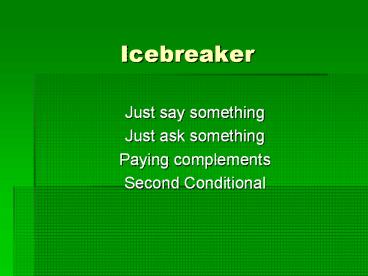Icebreaker - PowerPoint PPT Presentation
Title: Icebreaker
1
Icebreaker
- Just say something
- Just ask something
- Paying complements
- Second Conditional
2
Tutoring Overview
- 1 "What do I do first?" "How do I know what to
teach?"Gather information, needs assessment, set
goals, get needed materials - 2 "How should I structure my tutoring
sessions?"Follow an organized format. - 3 "What factors can help or hinder a student's
English learning ability?" Consider personal,
cultural, and linguistic factors. - 4 "How do I make a lesson plan that is
appropriate for my student?" Set reasonable
objectives provide appropriate materials and
activities. - 5 "How do I document students' progress and
evaluate their success?"Use formal and informal
means. - 6 "How can I evaluate my performance as an ESL
tutor?"Use simple self-assessment procedures.
3
Assessing Students Needs
4
In order to successfully teach a second or
foreign language to adults, teachers recognize
that, at a very practial level they must
constatly adjust their methods and materials on
the basis of their identification of the local
needs of their students.
Tarone, E Yule, G. 1989
- Do you agree?
- Is it possible in our classes today?
- How can we do it?
5
Advantages of Using Pre-Assessment
- Determine student mastery and/or learning gaps
- Avoid teaching students what they already know
- Guide instruction to challenge students
appropriately
6
- Use planning and instructional time effectively
- Motivate students to be more involved in and
attentive to instruction - Plan more engaging, relevant and meaningful
instruction - Identify students who have extensive background
knowledge in order to form expert groups
7
How do we assess students needs?
- What do you do in your classess?
- What do schools often do?
- Are these methods effective? Why or why not?
8
Global Needs
- What is the aim of learning?
- Use of questionnaire and interview to assess
needs - What if there seems to be no clear aim? i.e.
English is a requirement
9
Questions to ask
- Who are the learners?
- Why is the English language needed?
- How and where will it be used?
- With whom and when?
- Why are the learners taking this class?
- What resources are available?
- Where / when will the class take place?
- What is the broader context?
- What different learning styles are there?
10
4 Corners Drawing
My favoirte Hobby is. I want to learn English because
I day I would like to. A personal challenge I have is.
11
Story Telling Assessment
12
What can we do to assess student needs?
- Oral and written interviews
- Journals
- Games (Thumbs up) (Keep talking)
- Individual or group observations
- Surveys
- Set focus groups
- Research your students language and educational
background - Story telling
13
Learner Styles
- Visual
- Auditory
- Tactile/Kinesthetic
- Independent vs. Social
- Multiple Intelligences visual-spatial,
linguistic, logical/mathematical, musical,
intrapersonal, interpersonal, naturalist
14
Learner Style Tests
- http//www.edutopia.org/multiple-intelligences-lea
rning-styles-quiz - http//www.bgfl.org/bgfl/custom/resources_ftp/clie
nt_ftp/ks3/ict/multiple_int/
15
Analysis in Terms of Communicative Competence
- Grammatical Competence
- Sociolinguistic Competence
- Strategic Competence
- Students need all three unless specific needs
deem otherwise
16
Competencies Case Study
- With your group create a student who
specifically only needs one or two competencies. - Class will interview the student and guess what
competencies he/she needs-
17
How can linguistics help us think differently
about students needs?
- Student language can be divided into a number of
linguistic catagories - Pragmatics
- Semantics
- Syntax
- Morphology
- Phonology
18
So what?
- Why are these categories important to teachers
and students - Pragmatics
- Semantics
- Syntax
- Mophology
- Phonetics







![get⚡[PDF]❤ Hey Ice, Prepare to Get Broken: Icebreaker Questions Book for Work, Small PowerPoint PPT Presentation](https://s3.amazonaws.com/images.powershow.com/10061119.th0.jpg?_=202406210512)























![[PDF] DOWNLOAD The Farting Christmas Coloring Book PowerPoint PPT Presentation](https://s3.amazonaws.com/images.powershow.com/10053119.th0.jpg?_=202406110611)